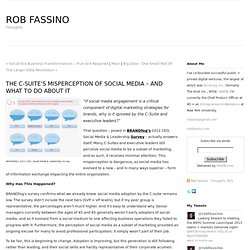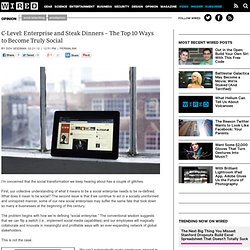

Social Media to Marketers: Get Over Yourself! Heidi Cohen | May 29, 2012 | 2 Comments inShare80 Five ways to break through.

Is your firm still sitting on the sidelines debating whether it should jump into the social media fray? If so, chances are your discussion is probably centered on the wrong issues. The evolution of business. The social business movement appears to be in full swing.

Over the past weeks, I have read time and time again that 2012 will be the year of social business (Business Computing World, SXSW, We are social). In terms of awareness, I totally agree; in terms of achieving our goals, perhaps that is too ambitious in such a short time period. I believe that the notion of 2012 being the year of social business is rooted in a misunderstanding of what social business actually means. I do not intend to go down the slippery road of trying to create a definition..
Stop Talking About Social and Do It. “Leadership” has changed when a decentralized group of people can take down a government.

“The Value Chain” has changed when the customer is no longer just the “buyer” but also a co-creator. “Human Resources” have changed when most of the people who create value for your organization are neither hired nor paid by you. “Competition” has changed when individuals can create value through a centralized network of resources: for example, designing a product from anywhere, producing it through a 3D factory, financing it through community and distribution from anywhere to anywhere. Yet our business models have not changed to keep pace with these shifts. This five-part series has shared case studies and examples of how the social era affects all areas of the business model: how we create, deliver, and capture value. Here’s a quick visual summary of what we’ve covered so far: These changes are not transitory or reversible, but fundamental and irrevocable. From paid to purpose-driven. Rfassino - Rob Fassino - Thoughts. - The C-Suite’s Misperception Of Social Media – And What To Do About It.
BRANDfog’s 2012 CEO, Social Media & Leadership Survey“If social media engagement is a critical component of digital marketing strategies for brands, why is it ignored by the C-Suite and executive leaders?”

That question – posed in BRANDfog’s 2012 CEO, Social Media & Leadership Survey – actually answers itself. Many C-Suites and executive leaders still perceive social media to be a subset of marketing, and as such, it receives minimal attention. This misperception is dangerous, as social media has evolved to a new – and in many ways superior – form of information exchange impacting the entire organization. Why Has This Happened?
BRANDfog’s survey confirms what we already knew: social media adoption by the C-suite remains low. To be fair, this is beginning to change. Jump-Starting C-Suite Social Media Participation To that end, I would suggest the following starting point: replace executives' industry information sources with social media streams and the tools/training to view them. Social media is about social science not technology. InShare1,106 In 2007, I wrote an article entitled, “Social Media is About Sociology Not Technology.”

It’s a statement that after five years (and counting), I thankfully continue to see shared every day on Twitter. FINALLY, Microsoft Embraces Social. The Social-Media Revolution Is Over: Time to Get Serious Why Social Marketing Is So Hard - Nilofer Merchant. What does the Extinction of Dinosaurs and Social Business have in Common? Social Media Sentiment Analysis Offering Launched. Dear Google, It's Not You, It's Us. Social hubs - what are they and why you may need one? 4 Social Hub Examples As the number of social networks increases, brands have started to look at ways in which they can bring all their social networks into their brand owned websites.

Contrast this with the more common situation where the only reference to social media on the main site are the ubiquitous Facebook, Twitter, LinkedIn and Google+ share buttons. These don’t give any impression of the type of interactions and communities developed on these networks or customers own networks. Social media in the C-Suite. Caterina Fake: Fast Growth for a Social App Is a Very Bad Thing - Liz Gannes - Social. Social Web entrepreneurs with successful careers just can’t seem to find their way to a happy and boring retirement.

Fancy turns social discovery into social commerce. Thingd, a quiet New York start-up founded by entrepreneurial wunderkind Joe Einhorn, is looking to become the biggest player in the nascent social commerce space with a blend of Pinterest, a huge database of objects and a new shopping model that combines discovery, demand and commerce.

Thingd, which has backing from Twitter’s Jack Dorsey and French luxury conglomerate PPR, has focussed its aspirations on consumer web project Fancy, a self-expression social destination similar to Pinterest that lets people “fancy” things they like. The site, which boasts about 250,000 users, launched a little over a year ago and has gotten praise for its slick look and style. It’s also struck deals with 400 retail and brand partners, who offer Fancy users discounts when they buy items they find on the site. Now Fancy is set to launch a new demand-driven commerce model that will let brands and retailers sign up to be a seller on any item that’s been fancied on the site. C-Level: Social Enterprises and Steak Dinners: 10 Ways to Become Truly Social.
I’m concerned that the social transformation we keep hearing about has a couple of glitches.

First, our collective understanding of what it means to be a social enterprise needs to be re-defined. What does it mean to be social? The second issue is that if we continue to act in a socially uninformed and uninspired manner, some of our new social enterprises may suffer the same fate that took down so many e-businesses at the beginning of this century. The problem begins with how we’re defining “social enterprise.” The conventional wisdom suggests that we can flip a switch (i.e., implement social media capabilities) and our employees will magically collaborate and innovate in meaningful and profitable ways with an ever-expanding network of global stakeholders. This is not the case. I heard a compelling speaker talk about flipping the switch on social enterprises at a dinner I attended recently. 3 accurate metrics for ROI on social media campaigns. Businesses are struggling with how to evaluate the effectiveness of their social media campaigns.

Currently, most companies are using a variety of metrics to measure diverse campaigns across multiple departments. These metrics fail to provide an overarching picture of which marketing programs are increasing their revenues. Hoo-ah: How the US Army Has Become a Social Media Leader. Over the past several years, the US Army has developed an exemplary program in exploiting numerous social media methods, and done so without a lot of flash, expense, or personnel.
They have an engaged audience, numerous followers, and maintained a multi-pronged campaign into all of the major social media networks, including recent beach-heads in Pinterest and Google+. All this, and with a five-person team based in the Pentagon and without spending much in the way of budget too. They are a worthy case study for organizations that are trying to make their own assaults on social media and haven't been as effective. Just look at this slide showing the numbers. Report: Content and the New Marketing Equation. InShare318 Rebecca Lieb, my colleague at Altimeter Group released a new report, “Content: The New Marketing Equation Why Organizations Must Rebalance.” The report helps organizations find balance in the creation of effective content strategies while delivering value to stakeholders and consumers and also the bottom line.
It’s safe to assume that the attention of the audience as we knew it is waning. And when we look at the online and mobile behavior of connected customers, a sense of responsibility emerges as everyday people become media beacons in their own right. As such, they rigorously share and curate for their audience with an editorial-style approach as what was once a static audience is now an audience with an audience of audiences. Such is true for organizations. When is the social curation bubble going to burst? You just can’t move for social curation services right now. The biggest noise might be coming from Pinterest, which is growing like a weed — but whether it’s the new-look Delicious, Switzerland’s Paperli, shopping curation site Svpply, image service Mlkshk or another site, the fact is that almost everybody seems to want to help you save and sort and share the things you find on the web right now.
With this swirl of activity, then, it’s no surprise to hear that Parisian service Pearltrees — slogan “collect, organize, discover” — has just raised another $6 million of funding, led by local conglomerate Groupe Accueil. The company, which has been running in public since 2009, welcomed the injection of funds as a way to help expand and scale up its system for bookmarking and organizing, which is based around a clustered visual interface. And it needs that scale. Right now Pearltrees is small and has moderate momentum, building up 350,000 users in the past three years. Recruiters Use LinkedIn And Twitter (But Not Facebook) To Source Job Candidates [INFOGRAPHIC] The Social Media Salary Guide [INFOGRAPHIC] Social Media Week is upon us, so we thought it would be appropriate to delve into the social media industry and see how its salaries stack up.
Social media is an evolving and cutting-edge field, so it should come as no surprise that you can make a great living managing a brand's presence on Twitter, Facebook, YouTube, Tumblr, LinkedIn, Google+, Pinterest, Instagram, Foursquare and other social platforms. In the infographic below, produced by OnwardSearch, you can see where the social media jobs are concentrated, the breakdown of job titles in the industry, and how much dough the average social mediate is bringing home each year. (The graphic shows the 25th and 75th percentiles for salary, pulled from Indeed).
Does this stack up with what you've seen in the industry?